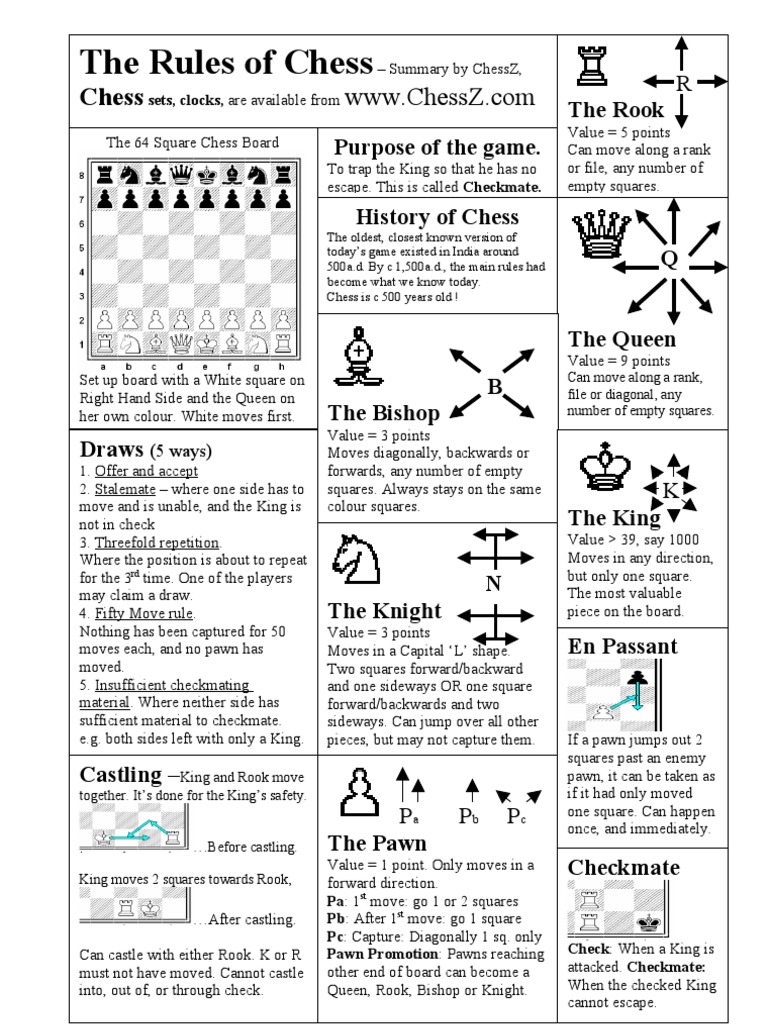In this post, we will delve into the fascinating world of chess rules, exploring the basic principles of this ancient and strategic game. Chess is a game that has both intrigued and challenged players for centuries. It is a mind sport that requires strategic thinking, concentration, and foresight. Whether you are a seasoned player looking to brush up on your skills or a beginner eager to learn the fundamentals, this guide will provide you with a comprehensive overview of chess rules.
Understanding the Chessboard
 The chessboard consists of 64 squares, alternating in color between dark and light. It is set up so that each player has a light-colored square on their bottom right. The chess pieces are arranged on the board in a specific order at the beginning of the game.
The chessboard consists of 64 squares, alternating in color between dark and light. It is set up so that each player has a light-colored square on their bottom right. The chess pieces are arranged on the board in a specific order at the beginning of the game.
Pieces and Their Movement
Now, let’s explore the different pieces and their movement:
- King: The king is the most important piece on the board. It can move one square in any direction.
- Queen: The queen is the most powerful piece. It can move any number of squares in any direction - horizontally, vertically, or diagonally.
- Rook: The rook can move any number of squares horizontally or vertically.
- Bishop: The bishop can move any number of squares diagonally.
- Knight: The knight has a unique movement pattern. It moves in an L-shape - two squares in one direction and one square in a perpendicular direction.
- Pawn: The pawn can move forward one square, but for its first move, it has the option to move forward two squares. Pawns capture pieces diagonally.
Objective of the Game

Special Moves and Notations
There are a few special moves in chess that are worth mentioning:
- Castling: Castling is a move that involves the king and one of the rooks. It is the only move in which two pieces can be moved at the same time. Castling is done to safeguard the king and bring the rook into play.
- En Passant: En passant is a capture that can only occur immediately after a pawn moves two squares from its starting position and lands next to an opponent’s pawn. The opponent then has the opportunity to capture the pawn “en passant.”
- Promotion: When a pawn reaches the opposite side of the board, it can be promoted to any other piece, except for a king. This allows players to exchange their pawn for a more powerful piece.
Enhancing Your Skills
 Improving your chess skills requires practice and a deeper understanding of strategy and tactics. Familiarize yourself with common opening moves, study classic games played by grandmasters, and solve chess puzzles to enhance your critical thinking abilities. Remember, mastering chess is a continuous journey, and every game you play will contribute to your progress.
Improving your chess skills requires practice and a deeper understanding of strategy and tactics. Familiarize yourself with common opening moves, study classic games played by grandmasters, and solve chess puzzles to enhance your critical thinking abilities. Remember, mastering chess is a continuous journey, and every game you play will contribute to your progress.
Conclusion
Chess is a timeless game that challenges the mind and fuels strategic thinking. By understanding the basic rules and practicing regularly, you can unlock the numerous possibilities and complexities that this game offers. So, grab a chessboard, set up the pieces, and embark on a journey of thought-provoking battles with your opponents, both near and far.